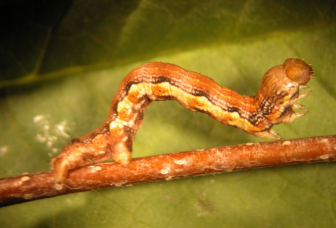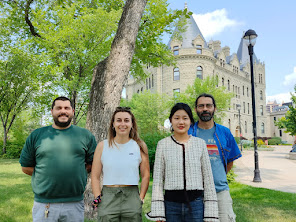If you walk by trees in Winnipeg between the end of May and the middle of June, you will probably meet some little creatures that seem to levitate beneath the trees. These little guys are called cankerworms.
There is multiples species of cankerworms, which belongs to the family of caterpillars. In our blog, we will focus on three different species :
- Spring cankerworms (Paleacrita vernata)
- Fall cankerworms (Alsophila pometaria)
- Elm spanworms (Ennomos subsignaria)
🐛 The spring and fall cankerworms 🐛
Have you ever wondered where the name cankerworm comes from?
Well, scientists gave them that name because of the way they move : by forming a loop with the central part of their body and then extending the front to straighten out. They give the impression of measuring the ground they cover. The name "cankerworm" refers to medieval surveyors who used a surveyor's rope to measure distances on the ground. [1]
The spring and fall cankerworm can both have the same colours ranging from yellowish-green to greenish-brown to black.
The only way to distinguish them is to look at their back legs. The spring cankerworm have 2 pairs of back legs while the fall cankerworm have 3.
 |
|
 |
Fall cankerworm with 3 pairs of back legs (first pair is reduced) [2] |
The cankerworms are phyllophages, i.e. they feed on the leaf tissue of plants. During the spring, they caused a lot of damage on certain species of trees. They really like hardwood trees like elm, ash, oak, maple, cherry, or linden.
They usually appear in the early spring and disappear in the middle of June.
Here is a short video explaining the life cycle of the cankerworm.
🐛 The elm spanworms 🐛
Unlike cankerworms, which tend to be green or dull brown, elm spanworms can be identified by their orange heads, purplish-black bodies and grippy, pincer-like feet. [3]
 |
Elm spanworm with its orange head [4] |
As cankerworms, the spanworm's eggs overwinter on trees. Eggs hatch May begin in mid-to late May. Then, they feed on trees during approximately 6 weeks. The difference between cankerworms and spanworms is on the pupation stage : elm spanworms pupate by spinning coarse netlike cocoons of silken threads often on partially defoliated leaves. Finally, adults emerge in late June through July and put the eggs on the trees. [5]




No comments:
Post a Comment